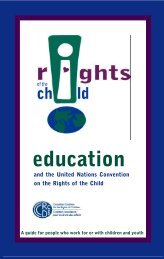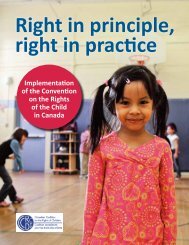Poste - Canadian Coalition for the Rights of Children
Poste - Canadian Coalition for the Rights of Children
Poste - Canadian Coalition for the Rights of Children
Create successful ePaper yourself
Turn your PDF publications into a flip-book with our unique Google optimized e-Paper software.
articles 13, 14 and<br />
15 (cont’d)<br />
• <strong>Children</strong> in care may be<br />
unaware <strong>of</strong> <strong>the</strong>ir rights<br />
and many report that <strong>the</strong>ir<br />
views are <strong>of</strong>ten not heard.<br />
• The state has assumed <strong>the</strong><br />
role <strong>of</strong> parent <strong>for</strong> children<br />
in care and is directly<br />
responsible <strong>for</strong> <strong>the</strong><br />
protection <strong>of</strong> <strong>the</strong>ir rights.<br />
• Some provinces and<br />
territories do not have an<br />
independent advocate to<br />
hear complaints <strong>of</strong><br />
children in care.<br />
NEEDS ACTION: All<br />
children should be aware <strong>of</strong><br />
<strong>the</strong>ir fundamental freedoms,<br />
<strong>the</strong> rights <strong>of</strong> o<strong>the</strong>rs and <strong>the</strong><br />
responsibilities that<br />
accompany freedom.<br />
<strong>Children</strong>’s rights education<br />
should be a mandatory part<br />
<strong>of</strong> school curricula.<br />
• It appears that many<br />
children are not taught<br />
about rights and freedoms<br />
in Canada.<br />
NEEDS DISCUSSION:<br />
There is little consensus and<br />
awareness about children’s<br />
fundamental freedoms.<br />
Some areas requiring<br />
discussion include:<br />
• What constitutes<br />
unreasonable infringement<br />
on fundamental freedoms?<br />
• How should environments<br />
in which children develop,<br />
such as schools, regulate<br />
freedom <strong>of</strong> expression?<br />
• How should <strong>the</strong>se<br />
environments respect<br />
freedom <strong>of</strong> religion?<br />
C A N A D I A N C O A L I T I O N F O R T H E R I G H T S O F C H I L D R E N<br />
UN Reporting Category:<br />
Family Environment and Alternative Care<br />
convention article 19<br />
10<br />
Abuse and Neglect<br />
Article 19 requires countries to take broad measures to protect children from<br />
maltreatment, including violence, abuse and neglect. In Canada, provincial and<br />
territorial child welfare systems are responsible <strong>for</strong> child protection.<br />
Child welfare legislation recognizes that families are primarily responsible <strong>for</strong> <strong>the</strong> care,<br />
supervision and protection <strong>of</strong> <strong>the</strong>ir children but when a child is at risk, <strong>the</strong> government<br />
has <strong>the</strong> duty to intervene to protect <strong>the</strong> child. Child protection services investigate<br />
cases <strong>of</strong> suspected abuse and neglect and, depending on <strong>the</strong> circumstances, can elect<br />
to provide support services to a family or remove <strong>the</strong> child from <strong>the</strong> family home.<br />
Removing a child from <strong>the</strong> family home is referred to as “taking a child into care.”<br />
<strong>Canadian</strong> legislation allows parents, teachers and persons “standing in <strong>the</strong> place <strong>of</strong> a<br />
parent” to use corporal punishment against children, even though physical punishment<br />
has been strongly linked to physical abuse. In fact, one Ontario study found problems<br />
with punishment or discipline to be a factor in 72 percent <strong>of</strong> substantiated physical<br />
abuse cases. Section 43 <strong>of</strong> <strong>the</strong> Criminal Code allows “reasonable <strong>for</strong>ce” to be used<br />
against children and this provision has been used to justify a child being punched in<br />
<strong>the</strong> face or pushed down a flight <strong>of</strong> stairs. In Canada, children are <strong>the</strong> only category<br />
<strong>of</strong> persons who can be subject to physical assault without due process.<br />
Canada has no national statistics on <strong>the</strong> number <strong>of</strong> children who are reported to<br />
child protection authorities because provincial and territorial child welfare systems<br />
collect and report data in different ways. The federal government is working with <strong>the</strong><br />
provinces and territories to begin collecting and analyzing data on reported cases <strong>of</strong><br />
child abuse and neglect.<br />
Recent inquests and child death reviews have publicized tragic failures <strong>of</strong> child welfare<br />
systems and hundreds <strong>of</strong> recommendations <strong>for</strong> improvement have been made over <strong>the</strong><br />
past few years. As a result, some <strong>Canadian</strong> child protection systems are broadening <strong>the</strong><br />
grounds <strong>for</strong> finding a child in need <strong>of</strong> protection and developing tools to systematically<br />
assess levels <strong>of</strong> risk. Systems are also trying to improve case management and<br />
in<strong>for</strong>mation sharing within and across jurisdictions. O<strong>the</strong>r ongoing child welfare<br />
re<strong>for</strong>ms include workload standards and better training <strong>for</strong> child protection workers<br />
and <strong>the</strong> education <strong>of</strong> pr<strong>of</strong>essionals and <strong>the</strong> public about <strong>the</strong> obligation to report<br />
suspected child maltreatment.




